
|

|
(Left) During her White House years, Mary Todd Lincoln faced many personal difficulties generated by political divisions within
the nation. Her family was from Kentucky, a Border State, where slavery was permitted. In Kentucky, siblings were
often on opposing sides of the Civil War — and Mary's family was no exception. Six of her seven brothers served in the
Confederate Army, with many killed-in-action, and one brother served the Confederacy as a surgeon. (Right) Mary Todd's cousin
was John Cabell Breckinridge, a former U.S. vice president and the highest ranking public official to ever commit treason. Breckinridge completed four years as vice president under James Buchanan, ran for president
(against Lincoln) as the Southern Democratic candidate in 1860 before returning to the Senate to lead the remnants of the Democratic Party for the first congressional session during the Civil War, and during the
four year conflict he served with distinction as a Confederate general. Once
Breckinridge volunteered his services to the Confederate army, the United States
Senate formally expelled him as a traitor, thus causing from cities to landmarks which had been named in honor of the former
vice president, to adopt a new name, hence the present spelling of Breckenridge with the letter "e" replacing the "i".
After
the American Revolution, the counties of Virginia beyond the Appalachian Mountains became known as Kentucky County. Eventually,
the residents of Kentucky County petitioned for a separation from Virginia. Ten constitutional conventions were held
in the Constitution Square Courthouse in Danville between 1784 and 1792. In 1790, Kentucky's delegates accepted Virginia's
terms of separation, and a state constitution was drafted at the final convention in April 1792. On June 1, 1792, Kentucky
became the fifteenth state to be admitted to the union. Isaac Shelby, a military veteran from Virginia, was elected the first
Governor of the Commonwealth of Kentucky.
Kentucky, also known as the Bluegrass State, claims as native sons and
daughters many of the leading figures of the American Civil War era (1861-1865), such as Abraham and Mary Todd Lincoln and
Jefferson Davis. One of Kentucky’s more prominent nineteenth century Senators, Henry Clay, spent much of his career
trying to compromise the issue of slavery before the war. His most well-known efforts were in crafting the Missouri Compromise of 1820 and the Compromise of 1850.
As clear from these most prominent residents, Kentucky was a state of
divided loyalties and families torn apart. Nowhere was this division more evident than in the "First Family." Abraham Lincoln
was born in Kentucky, and several members of Mary Todd Lincoln's family fought for the South. Another family similarly divided
was that of U.S. Senator John Crittenden, whose two sons were generals on opposite sides. Some historians even say that the
ensuing family feuds, such as the Hatfields and the McCoys, carried on the war in Kentucky long after its official end.
In 1861, Kentucky’s governor, Beriah Magoffin, favored secession,
but the legislature voted to remain neutral. The major slaveholding areas in the Bluegrass Region and the western counties
favored the Confederacy and sent many recruits to its army. Early in the war, however, the Union army entered Kentucky. By
the end of the Battle of Perryville in 1862, Confederate forces had retreated from the state. Although a rival secessionist
government was formed, it had little power. For the remainder of the war, Kentucky was the target of Confederate raids by
John Hunt Morgan, William Quantrill, Nathan Bedford Forrest and “Sue” Mundy. These raiders destroyed supply lines,
depots, public and private property.
When President Lincoln issued the Emancipation Proclamation in 1863, it did not apply to Kentucky or to any of the Border States. However, when he offered freedom to slaves who joined the Union army, numerous
slaves fled to Camp Nelson, Kentucky, which became a recruitment center and major fugitive slave camp.
By 1864, war-weary Kentuckians demanded an end to the conflict, and, with
much conviction, they believed that Lincoln had failed the nation. Kentucky voters, by more than 2-to-1, overwhelmingly favored
the Peace Platform offered by the Democrats. "Always maintaining that loyalty to the Federal government was one thing, and
that approval of the acts of the Lincoln Administration was distinctly another, the people of the state registered their verdict
upon the latter question at the presidential election of 1864, when they gave McClellan, a former Union general, a vote
of 64,301, and Lincoln 27,786, a majority for McClellan of 36,515." See also Kentucky in the American Civil War: Kentucky (1861-1865) and Kentucky and the Civil War:
A Short History.
| Kentucky in the Civil War Map |
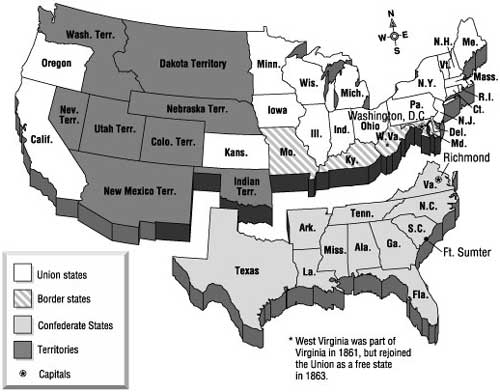
|
| Kentucky was a Border State during the Civil War |
Slavery
The history of slavery in Kentucky dates from the earliest permanent
European settlements in the state until the end of the American Civil War (1861-1865). Although Kentucky was generally classified
as the Upper South or a Border State, rather than the Deep South, enslaved African Americans made up a substantial percentage
of the population. Early Kentucky history was built on the labor of slavery, and it was an integral part of the state. From
1790 to 1860 the slave population of Kentucky was never more than one quarter of the total population, with lower percentages
after 1830 as planters sold slaves to the Deep South. Slave populations were greatest in the central "bluegrass" region of
the state, which was rich in farmland. In 1850, 23 percent of Kentucky's white males held enslaved African Americans.
Early travelers to Kentucky in the 1750s and 1760s brought their slaves
with them. As permanent settlers started arriving in the late 1770s, they held slaves in the station-based settlements, organized
around forts. Settlers, chiefly migrants from Virginia, continued to rely on slave labor as they established more permanent
farms.
Planters who grew hemp and tobacco made the greatest use of slave labor,
as these were labor-intensive crops. Subsistence farming could be done without slave labor. Some owners also used enslaved
African Americans in mining and manufacturing operations. Farms in Kentucky tended to be smaller than the plantations of the
South, so ownership of large numbers of slaves was uncommon. Many slaves had to find spouses on a neighboring farm, and often
fathers did not get to live with their wives and families.
Kentucky exported more slaves than did most states. From 1850 to 1860,
16 percent of enslaved African Americans were sold out of state. Many African Americans were sold directly to plantations
in the South, or transported by traders along the Ohio and Mississippi rivers to slave markets in New Orleans (hence the later
euphemism for any sort of betrayal, to be "sold down the river"). The sales were the result of reduced labor needs due to
changes in local agriculture, as well as substantial out-migration by white families from Kentucky. In the 1840s and 1850s,
white families migrated west to Missouri and Tennessee, even southwest to Texas. The larger slave-holding families took slaves
with them on forced migration to Tennessee and Missouri. These factors combined to create greater instability for enslaved
families in Kentucky than in some of the Deep Southern states.
Kentucky did not outlaw slavery during the Civil War, as Maryland and
Missouri (sister Border States) did. Nevertheless, about 75% of slaves in Kentucky were freed or escaped to Union lines
during the war. Slavery was abolished with ratification of the 13th Amendment in 1865. On December 18, 1865, Secretary of
State William H. Seward, proclaimed the 13th Amendment to have been ratified by the legislatures of 27 of the then 36 states.
Kentucky, however, was not listed among the 27, because it didn't ratify the amendment until March 18, 1976; more than a century
after ratification and 8 years after the assassination of Dr. Martin Luther King.
Sentiment
On April 15, 1861, President
Abraham Lincoln sent a telegram to Kentucky governor Beriah Magoffin requesting that the Commonwealth supply part of the initial
75,000 troops to put down the rebellion in the Southern states. Magoffin, a Southern sympathizer, replied: "President Lincoln,
Washington, D.C. I will send not a man nor a dollar for the wicked purpose of subduing my sister Southern states."
The Civil War divided few states as deeply as it did Kentucky. Some residents,
citing the state's history of supporting compromise and nationalism, wanted to remain with the Union. Others favored the Confederacy;
they concentrated on the state's ties to the South through culture—most importantly, by slave-owning—and through
family. Kentucky was the birthplace of Abraham Lincoln, his wife Mary Todd, former Vice President John C. Breckinridge, who
as a Confederate general would lead an attack on Washington, and Confederate President Jefferson Davis. All but one of Mary
Todd Lincoln's seven brothers and half-brothers, for example, fought against the Union that her husband was trying to preserve.
In an attempt to keep these divisions from widening further, the state legislature declared in May 1861, a month after the
firing on Fort Sumter, that it had decided to "occupy a position of strict neutrality."
Those who wanted to stay out of the growing conflict failed. Both the Union
and the Confederacy were trying to convince residents to support their side, for each understood how the state could help
in the war. Control of Kentucky would assist in the defense of other crucial territory and provide access to key transportation
routes. It had the third-largest white population of all the slave-holding states, so it contained a large number of potential
soldiers, and it produced wheat and livestock, supplies both sides would need. Recognizing these factors, President Lincoln
told a friend, "I think to lose Kentucky is nearly the same as to lose the whole game."
Unionists gradually came to dominate the state. Elections in May (for Congress)
and August (for the state legislature) both ended with significant victories for men who favored the North. Many Kentuckians
who had remained uncertain which side to support began to sympathize with the Union in September 1861, when Confederate General
Leonidas Polk took control of Columbus, a railroad junction that sat at the foot of a bluff overlooking the Mississippi River.
Although Union forces under the command of Union General Ulysses.S. Grant soon occupied two other towns in the state, General
Polk was the first to move, which created sympathy for the North.
Although Kentucky tilted towards the U.S., or Union, it remained far
from united. Each side recruited troops from the state, and these enlistments caused splits that ran through some families
for decades.
The following excerpts demonstrate how both the Union and the Confederacy
attempted to win the loyalty of the citizens of Kentucky. The first is from a speech given by Col. Curren Pope, commander
of the Seventh Kentucky Infantry US, at a ceremony in Louisville in October 1861. The second is from a proclamation issued
by Confederate Gen. Felix Zollicoffer, a former newspaper editor and Congressman from Tennessee, to the citizens of southeastern
Kentucky in December, 1861. In the fall of 1861 Zollicoffer had crossed the Cumberland Gap into Kentucky with 6,000 men, then
encamped near Mill Springs.
Colonel Pope:
"We behold emblazoned upon its [United States flag] bright folds the
same stars and stripes which the eyes of Washington were accustomed to look upon, and we rejoice with joy unspeakable that
it is still this day the consecrated flag of our Union. It has streamed in triumph at the mast-head of our ships, and in many
a bloody field has cheered the American armies on to victory. It has waved in every breeze on land and upon the sea, and in
the strong hands of our fathers who bore it aloft, it has never, lo, never dishonored. Around it have clustered the dearest
hopes of every friend of human liberty in every clime, and who doubts the last shriek of freedom will rend the skies, if it
shall fall forever....[t]hough others may hate and curse the land that gave them birth, the brave and loyal sons of Kentucky
will never strike with parricidal hands the State that has nurtured them. Sooner may the battle-field run purple with our
blood, and we fall, if fall we must, in civil strife, wrapping as a winding sheet these spangled colors around us and breathing
out our last sighs for our country's glory."
General Zollicoffer:
"To the People of Southeastern Kentucky:
The brigade I have the honor
to command is here for no purpose of war upon Kentuckians, but to repel those Northern hordes who, with arms in their hands,
are attempting the subjugation of a sister Southern State....We have come to open again your rivers, to restore the ancient
markets for your produce, and thereby to return to you the accustomed value of your lands and labor....We come to take you
by the hand as heretofore—as friends and brothers. Their government has laid heavy taxes on you to carry on this unnatural
war, one object of which is openly avowed to be to set at liberty your slaves, and the ensuing steps in which will be to put
arms in their hands and give them political and social equality with yourselves. We saw these things in the beginning, and
are offering our heart's blood to avert those dreadful evils which we saw the abolition leaders had deliberately planned for
the South.
How long will Kentuckians close their eyes to the contemplated ruin of their
present structure of society? How long will they continue to raise their arms against brothers of the South struggling for
those rights and for that independence common to us all, and which was guaranteed to all by the Constitution of 1787?...We
have broken their columns in almost every conflict. We have early acquired a prestige of success which has stricken terror
into the Northern heart. Their "grand armies" have been held in check by comparatively few but stern hearted men, and now
they would invoke Kentucky valor to aid them in beating down the true sons of the South who have stood the shock, and in bringing
common ruin upon Kentucky and her kindred people. Will you play this unnatural part, Kentuckians? Heaven forbid! The memories
of the past forbid! The honor of your wives and daughters, your past renown, and the fair name of your posterity forbid that
you should strike for Lincoln and the abolition of slavery against those struggling for the rights and independence of your
kindred race. Strike with us for independence and the preservation of your property, and those Northern invaders of your soil
will soon be driven across the Ohio."
While remaining loyal to the Union, Kentucky was a Border State during
the Civil War and was officially neutral until a new legislature took office on August 5, 1861, with pro-Union sympathies. On
September 4, 1861, General Leonidas Polk broke Kentucky's neutrality by invading Columbus, Kentucky. As a result of the Confederate
move, General U.S. Grant quickly entered Paducah, Kentucky. On September 7, 1861, the Kentucky State Legislature, angered
by the Confederate invasion, ordered the Union flag to be raised over the state capitol in Frankfort, declaring its allegiance
with the Union. In November 1861, during the Russellville Convention, Southern sympathizers attempted to establish an alternative
state government with the goal of secession but failed to displace the legitimate government in Frankfort. On August 13, 1862,
Confederate General Edmund Kirby Smith's Army of East Tennessee invaded Kentucky and on August 28, 1862, Confederate General
Braxton Bragg's Army of Mississippi entered Kentucky beginning the Kentucky Campaign. Bragg's retreat following the Battle
of Perryville left the state under the control of the Union Army for the remainder of the war. See also Civil War Turning Point: A List of Major and
Pivotal Turning Points.
"The position of Kentucky as one of the Border States imparted more than
ordinary interest to the political proceedings in the state. The legislature elected in August 1861, commenced its last session
at Frankfort early in January 1863. The measures presented in this body represented the views of the people of the state.
It was unequally divided, and the views of each division are to be found in the resolutions which they recommended for
adoption." On February 27, 1863, the assembly adopted numerous resolutions, which indicated both loyalty to the Union and
U.S. Constitution as well as its contempt for the Lincoln Administration. Resolutions 2, 5, and 8 summarize the state's sentiment:
"2. Resolved, That this general assembly declares, as before it has oftentimes
declared, that the state of Kentucky hath ever been, and is, loyal to the government of the United States of America, and
is determined to maintain that loyalty against both domestic and foreign foes.
"5. Resolved, That this general assembly declares that the power which has
recently been assumed by the president of the United States, whereby, under the guise of military necessity, he has proclaimed
and extended martial law over states where war did not exist, and has suspended the writ of habeas corpus, is unwarranted
by the constitution, and its tendency is to subordinate civil to military authority, and to subvert constitutional and free
government.
"8. Resolved, That Kentucky will adhere to the constitution and the
Union, as the best, it may be the last, hope of popular freedom; and for all the wrongs which may have been committed, or
evils which may exist, will seek redress under the constitution, and within the Union, by the peaceful but powerful and irresistible
agency of the suffrages of a free people.
"The state, nevertheless, continued its attitude of unswerving loyalty
to the Union until peace had been restored. The closing year of the war was fraught with much suffering and privation on the
part of the people of the state. Hostilities had degenerated into a guerrilla warfare of direful intensity, destructive of
both life and property, but through it all the gallant "Corncracker State" maintained consistently the position she had assumed
from the first. No state in the Union has a record that equals Kentucky's in the matter of consistent loyalty to expressed
ideals. Firm in her devotion to the Union she cheerfully furnished men and money to assist in preserving the same; and to
what she considered the unconstitutional acts of the administration she gave an emphatic condemnation by an overwhelming majority
at the ballot-box." See also Kentucky in the American Civil War: Kentucky
(1861-1865).
| Map of Kentucky politics and the Civil War |
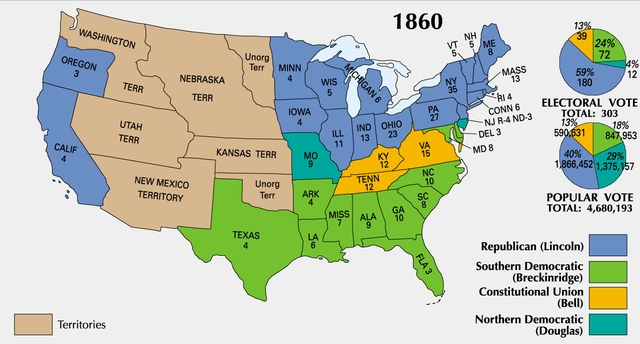
|
| Kentucky did not support Lincoln for president |
Secession
Kentucky's citizens were split regarding the issues central to the Civil
War. In 1860, slaves composed 19.5% of the Commonwealth's population, and many Unionist Kentuckians saw nothing wrong with
the "peculiar institution". The Commonwealth was further bound to the South by the Mississippi River and its tributaries,
which were the main commercial outlet for her surplus produce, although railroad connections to the North were beginning to
diminish the importance of this tie. The ancestors of many Kentuckians hailed from Southern states like Virginia, North Carolina,
and Tennessee, but many Kentucky children were beginning to migrate toward the North.
Kentucky, along with North Carolina, also boasted the best educational
systems in the South. Transylvania University had long been one of the most respected institutions of higher learning in the
nation, and while its reputation had begun to fade by 1860, other Kentucky schools like Centre College and Georgetown College
were gaining prominence.
Politically, the Commonwealth had produced some of the country's best
known leaders. Former Vice-Presidents John C. Breckinridge and Richard M. Johnson both hailed from the Bluegrass State, as
did Henry Clay and future President Abraham Lincoln. However, by the time of the Civil War, the Commonwealth was in a politically
confused state. The decline of the Whig Party, which Clay had founded, had left many politicians looking for an identity.
Many joined the increasingly popular Democratic Party, a few joined the newly-formed Republican Party, while still others
associated with one of numerous minor parties such as the Know Nothing Party.
Kentucky was strategically important to both the North and South. The
Commonwealth ranked ninth in population by 1860, and was a major producer of such agricultural commodities as tobacco, corn,
wheat, hemp, and flax. Geographically, she was important to the South because the Ohio River would provide a defensible boundary
along the entire length of the state.
Kentucky governor Beriah Magoffin believed that the rights of the Southern
states had been violated and favored the right of secession, but sought all possible avenues to avoid it. On December 9, 1860,
he sent a letter to the other slave state governors suggesting that they come to an agreement with the North that would include
strict enforcement of the Fugitive Slave Act, a division of common territories at the 37th parallel, a guarantee of free use
of the Mississippi River, and a Southern veto over slave legislation. Magoffin proposed a conference of slave states, followed
by a conference of all the states to secure these concessions. Due to the escalating pace of events, neither conference was
ever held.
Magoffin called a special session of the Kentucky General Assembly on
December 27, 1860, and asked legislators for a convention of Kentuckians to decide the Commonwealth's course regarding secession.
The majority of the General Assembly had Unionist sympathies, however, and declined the governor's request, fearing that the
state's voters would favor secession. The Assembly did, however, send six delegates to a February 4 Peace Conference in Washington,
D.C., and asked Congress to call a national convention to consider potential resolutions to the secession crisis, including
the Crittenden Compromise, authored by Kentuckian John J. Crittenden.
When the General Assembly convened again on March 20, it called for
a convention of the Border States in the Kentucky capital of Frankfort on May 27, 1861. Again, the call went unheeded. Legislators
also passed a proposed Thirteenth Amendment to the Constitution that would have guaranteed slavery in states where it was
already legal.
The tide of public opinion was beginning to turn in Kentucky, however.
In a special congressional election held June 20, 1861, Unionist candidates won nine of Kentucky's ten congressional seats.
Confederate sympathizers won only the Jackson Purchase region, which was economically linked to Tennessee by the Cumberland
and Tennessee Rivers. Seeing imminent defeat at the polls, many Southern Rights Advocates boycotted the election; the total
number of ballots cast was just over half the number that had been cast in the previous year's election. Governor Magoffin
was dealt a further blow in the August 5 election for state legislators. This election resulted in veto-proof Unionist majorities
of 76–24 in the House and 27–11 in the Senate.
From that point forward, most of Magoffin's vetoes to protect Southern
interests were overridden in the General Assembly. After clashing with the Assembly for over a year on even the most trivial
issues, Magoffin decided that resignation was his only option. Magoffin's lieutenant governor, Linn Boyd, had died in office,
and Senate Speaker John Fisk, next in line for the governorship, was not acceptable to Magoffin as a successor. In an intricate
plan worked out with the General Assembly, Fisk resigned as speaker and the Senate elevated Magoffin's chosen successor, James
F. Robinson, to the post. Magoffin then resigned, promoting Robinson to governor, and Fisk was re-elected as Senate Speaker.
Almost immediately following the results of the 1861 election, William
"Bull" Nelson established Camp Dick Robinson, a Union recruiting camp, in Garrard County. When Crittenden objected to this
violation of Kentucky's neutrality, Nelson replied, "That a camp of loyal Union men, native Kentuckians, should assemble in
camp under the flag of the Union and upon their native soil [and] should be a cause of apprehension is something I do not
clearly understand." Governor Magoffin appealed to President Lincoln to close the camp, but he refused. Meanwhile, Confederate
volunteers covertly crossed the Tennessee border and massed at Camp Boone, just south of Guthrie. Kentucky's fragile neutrality
was nearing an end.
The elected government of Kentucky being decidedly Union, a group of Southern
sympathizers began formulating a plan to create a Confederate shadow government for the Commonwealth. Following a preliminary
meeting on October 29, 1861, delegates from 68 of Kentucky's counties met at the Clark House in Russellville, Kentucky on
November 18. The convention passed an ordinance of secession, adopted a new state seal, and elected Scott County native George
W. Johnson as governor. Bowling Green, now occupied by General Johnston himself, was designated as the state capital, though
the delegates provided that the government could meet anywhere deemed appropriate by the provisional legislative council and
governor. Being unable to flesh out a complete constitution and system of laws, the delegates voted that "the Constitution
and laws of Kentucky, not inconsistent with the acts of this Convention, and the establishment of this Government, and the
laws which may be enacted by the Governor and Council, shall be the laws of this state." Though President Davis had some reservation
about the circumvention of the elected General Assembly in forming the Confederate government, Kentucky was admitted to the
Confederacy on December 10, 1861. Kentucky was represented by the central star on the Confederate battle flag.
Though it existed throughout the war, Kentucky's provisional government
had very little effect on the events in the Commonwealth or in the war. When General Johnston abandoned Bowling Green in early
1862, the government's officers traveled with his army, and Governor Johnson was killed in active duty at the Battle of Shiloh.
Continuing to travel with the Army of Tennessee, the government re-entered Kentucky during Braxton Bragg's campaign in the
Commonwealth, but was driven out permanently following the Battle of Perryville. From that time forward, the government existed
primarily on paper, and dissolved following the war.
| Civil War Kentucky Map |
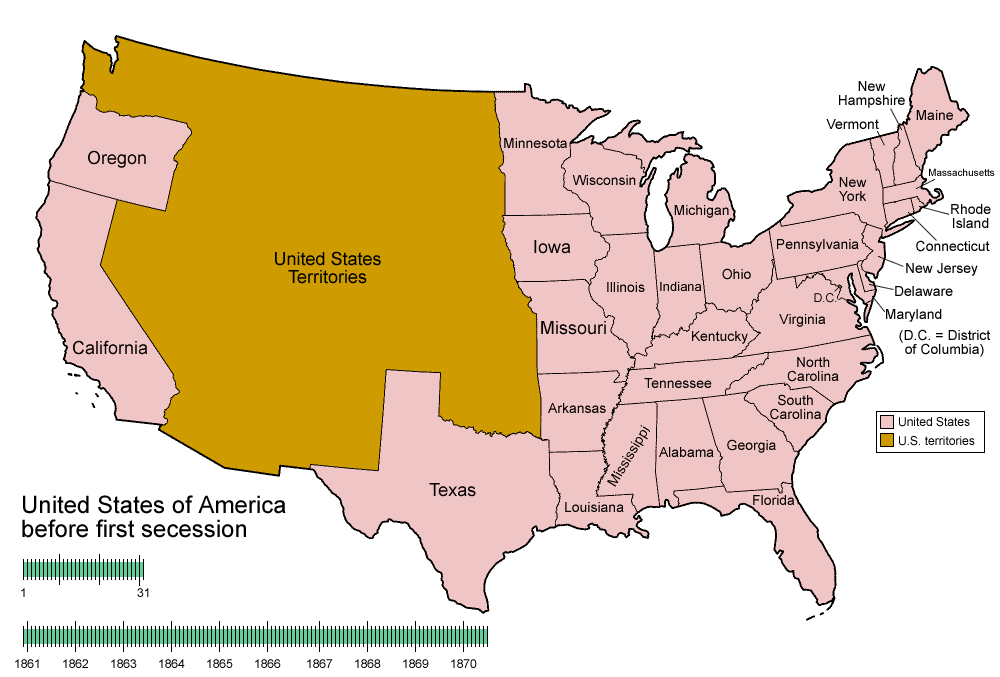
|
| Map depicts the Secession of Southern states and readmission to the Union dates |
| Kentucky in the Civil War Map |
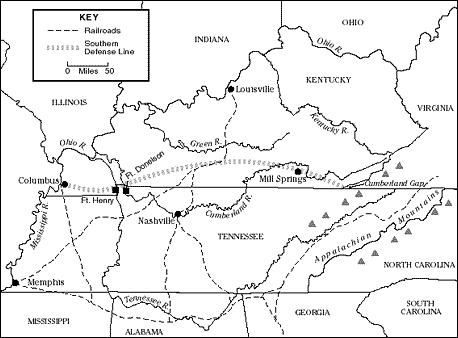
|
| Map of Southern Defense Line in Kentucky |
Civil War
According to the 1860 U.S. census, Kentucky had a free population of 930,201
and an additional slave population of 225,483. During the Civil War, according to statisticians Dyer (1908) and Phisterer
(1883), Kentucky provided 75,760 troops to the Union and approximately 35,000 to the Confederacy. Kentuckians in the
Union Army served in 45 regiments and 1 company of infantry, 16 regiments and 10 companies of cavalry, and 7 batteries
of artillery. Union men also joined Kentucky's numerous independent, unattached, state and militia units. As a result of Kentucky's
involvement in the conflict, according to Dyer, the state suffered 10,774 Union deaths and thousands more in wounded, while
Confederate casualties remain unknown.
The Union Army, vol. 4, states
that "The muster-rolls of the adjutant-generals office make the number of men furnished by the state to the Federal armies
to be 63,975 white soldiers on an enrollment of 113,410. The rolls in the same office further show that 20,438 colored
troops were mustered into the Federal service from the state. In addition, about 5,000 were enlisted preparatory to being
mustered in, making the aggregate of colored troops 25,438. Thus, with a white and black male population of 133,742 between
18 and 45 years of age, the state contributed to the Federal armies 89,413. Apart from this force, there were employed in
the service of the state for various periods 13,526 militia, or state troops."
Kentucky was a Border State of key importance in the Civil War (1861-1865). President Abraham Lincoln recognized
the importance of the Commonwealth when he declared "I hope to have God on my side, but I must have Kentucky." In a September
1861 letter to Orville Browning, Lincoln wrote "I think to lose Kentucky is nearly the same as to lose the whole game. ...
We would as well consent to separation at once, including the surrender of the capital."
Kentucky was among the chief places where the "brother against brother"
scenario was prevalent. Kentucky was officially neutral at the beginning of the war, but after a failed attempt by Confederate
General Leonidas Polk to take the state of Kentucky for the Confederacy, the legislature petitioned the Union for assistance,
and thereafter became solidly under Federal control.
Kentucky was the site of fierce battles, such as Mill Springs and Perryville. It was host to such military leaders as Nathan Bedford Forrest and Ulysses
S. Grant, who first encountered serious enemy gunfire coming from Columbus, Kentucky. Forrest proved to be a scourge
to the Union Army in such places as the towns of Sacramento and Paducah, where he conducted guerrilla warfare against Federal forces.
In 1861 both sides respected the Commonwealth's
neutrality, but positioned themselves strategically to take advantage of any change in the situation. Federal forces established
Camp Clay in Ohio just north of the city of Newport, Kentucky and Camp Joe Holt in Indiana opposite Louisville, Kentucky.
Meanwhile Confederate troops constructed Forts Donelson and Henry just across Kentucky's southern border in Tennessee, and stationed troops fewer than 50 yards from Cumberland Gap. Volunteers from the Commonwealth left the state to join up with whichever side they favored. Some covert recruiting
also took place. Nearly 60 infantry regiments served in the Union armies versus just 9 in the Confederate. However, a rather
large number of cavalry outfits joined the latter. John Breckenridge originally commanded the "Orphan Brigade" of the
Army of Tennessee, consisting of the 2nd, 3rd, 4th, 6th, and 9th Kentucky Infantry. The brigade's nickname came about allegedly
because the soldiers' home counties were occupied by Union troops for most of the war and they couldn't go home to them.
| Columbus and Paducah in the Civil War Map |
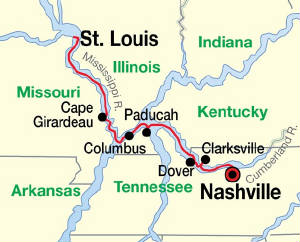
|
| Close proximity of Columbus and Paducah |
Realizing that neutrality was becoming less and less feasible, six prominent
Kentuckians met to find some solution for a state caught in the middle of a conflict. Governor Magoffin, John C. Breckinridge,
and Richard Hawes represented the states' rights position, while Crittenden, Archibald Dixon, and S. S. Nicholas advocated
the Northern cause. The sextet agreed only to continue the doctrine of neutrality, however, and called for the formation of
a five member board to coordinate the Commonwealth's defense. The General Assembly created the board on May 24 and vested
in it supervision of the state's military, a power reserved in the Kentucky Constitution for the governor.
The Commonwealth's military forces, however, proved to be just as divided
as the general populace. The State Guard, under the command of Simon B. Buckner, largely favored the Confederate cause, while
the newly-formed Home Guard were mostly Unionists. Several close calls almost started a conflict within the state, but Buckner
successfully negotiated with Union general George B. McClellan and Tennessee governor Isham Harris to maintain the Commonwealth's
neutrality through the summer.
On September 4, 1861, Confederate Major General Leonidas Polk violated
the Commonwealth's neutrality by ordering Brigadier General Gideon Johnson Pillow to occupy Columbus. Columbus was of strategic
importance both because it was the terminus of the Mobile and Ohio Railroad and because of its position along the Mississippi
River. Polk constructed Fort DuRussey in the high bluffs of Columbus, and equipped it with 143 cannons. Polk called the fort
"The Gibraltar of the West." To control traffic along the river, Polk stretched an anchor chain across the river from the
bank in Columbus to the opposite bank in Belmont, Missouri. Each link of the chain measured eleven inches long by eight inches
wide and weighed twenty pounds. The chain soon broke under its own weight, but Union forces did not learn of this fact until
early 1862.
In response to the Confederate advance, Union Brigadier General Ulysses
S. Grant left Cairo, Illinois, and entered Paducah, Kentucky, on September 6, which gave the Federal control of the northern
end of the New Orleans and Ohio Railroad and the mouth of the Tennessee River. Governor Magoffin denounced both sides for
violating the Commonwealth's neutrality, calling for both sides to withdraw. However, on September 7, 1861, the General Assembly
passed a resolution ordering the withdrawal of only Confederate forces. Magoffin vetoed the resolution, but both houses overrode
the veto, and Magoffin issued the proclamation. The General Assembly ordered the flag of the United States to be raised over
the state capitol in Frankfort, declaring its allegiance with the Union.
Its neutrality broken, both sides quickly moved to establish advantageous
positions in the Commonwealth. Confederate forces under Albert Sidney Johnston formed a line in the southern regions of Kentucky
and the northern regions of Tennessee, stretching from Columbus in the west to Cumberland Gap in the east. Johnston dispatched
Simon B. Buckner to fortify the middle of the line in Bowling Green. Buckner arrived on September 18, 1861, and immediately
began intensive drill sessions and constructing elaborate defenses in anticipation of a Federal strike. So extensive were
the fortifications at Bowling Green that a Union officer who later surveyed them commented, "The labor has been immense–
their troops cannot be well drilled– their time must have been chiefly spent in hard work, with the axe and spade."
| Kentucky Border State Map |
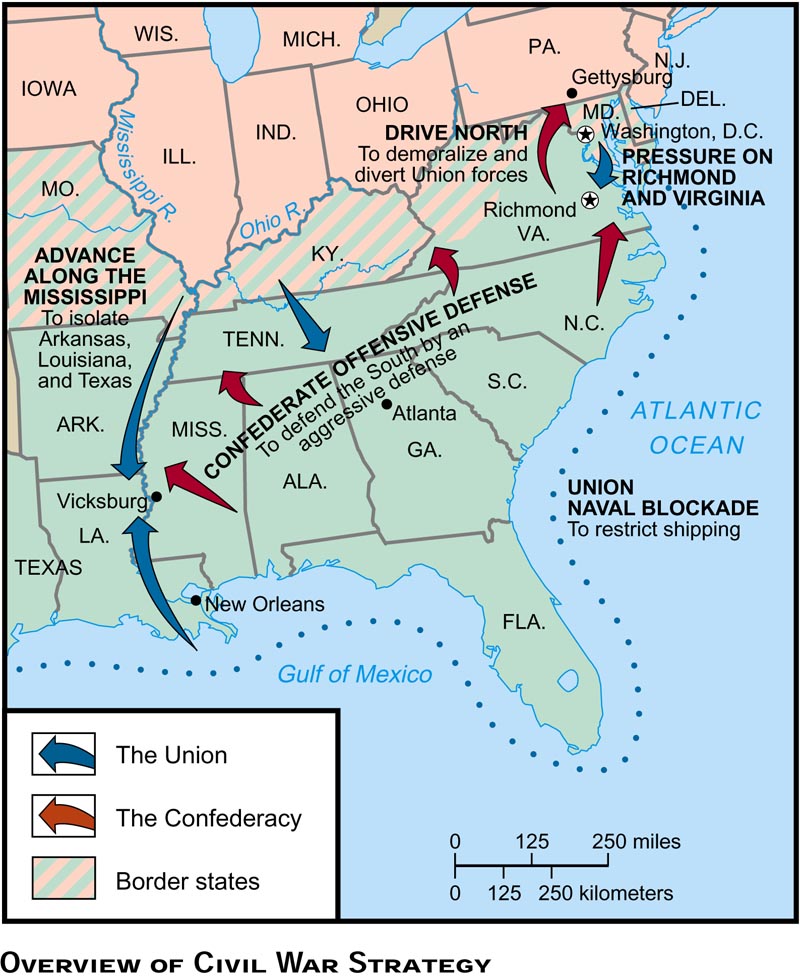
|
| As a Border State, Kentucky was literally caught in the middle of the fight |
Many small skirmishes occurred in Kentucky in 1861, including "Forrest's
First Fight" at Sacramento, but battles of great military significance did not begin in earnest until 1862.
In January 1862, Union General George H. Thomas began to advance on
George B. Crittenden's position at Mill Springs. In rainy conditions, Thomas' army moved slowly, and Crittenden advanced to
meet them before they could be reinforced by forces from nearby Somerset. The battle commenced on January 19, 1862, and favored
Crittenden's forces early on. However, in the confusion caused by the rain and fog, Felix Zollicoffer, commander of Crittenden's
First Brigade, rode into the midst of the Federal forces. A Confederate officer galloped in, yelling at Zollicoffer to inform
him of his mistake. Upon being identified, Zollicoffer was shot out of the saddle and killed, disheartening the Confederates
and turning the tide of the battle. Thomas' reinforcements arrived, and Crittenden's forces were forced to retreat across
the flooded Cumberland River. Many drowned in the process, and Crittenden was given the blame for the debacle.
General Johnston learned of Crittenden's defeat at Mill Springs through
an account of the battle printed in a Louisville newspaper. However, he had larger concerns, as Ulysses S. Grant was advancing
up the Cumberland and Tennessee Rivers toward Forts Henry and Donelson. Union ironclads routed the Confederate river gunboats
on the Mississippi River during the Battle of Lucas Bend on January 11, forcing them back to Columbus. Following Grant's victory
at the Battle of Belmont, General Polk had anticipated that Union forces would target the Mississippi River and attack Columbus,
and had withdrawn most of his forces to that location. Lloyd Tilghman was left to defend Fort Henry with fewer than 3,000
men. Federal troops began their assault on the fort on February 5, 1862, and Tilghman surrendered the following day.
General Johnston countered by ordering Pillow, Buckner, and John B.
Floyd to the defense of Fort Donelson. None of the three was specifically given command, a decision that would prove costly.
Grant arrived at Donelson on February 13, and found himself outnumbered by some 3,000 troops. Floyd failed to capitalize on
his advantage, however, and Grant was reinforced the next day. On February 15, the Confederates had nearly cleared an escape
route to Nashville, but arguments among the generals delayed the retreat. Floyd seized a steamboat and used it to evacuate
his forces, while Pillow fled in a rowboat. Buckner, left alone in command, proposed a cease-fire to Grant while terms of
surrender were negotiated. Grant's reply– that only "an unconditional and immediate surrender" could be accepted–
made him a hero in Union eyes, and earned him the nickname "Unconditional Surrender" Grant.
The collapse of Forts Henry and Donelson made Polk's position at Columbus
untenable; the Confederates were forced to abandon "The Gibraltar of the West." His line shattered, Johnston abandoned Bowling
Green on February 11, 1862, retreating first to Nashville, then further south to join P. G. T. Beauregard and Braxton Bragg
at Corinth, Mississippi. Cumberland Gap, the final piece of Johnston's line, finally fell to Union forces in June 1862.
Almost immediately following the Confederate withdrawal from Kentucky,
General John Hunt Morgan began the first of his raids into the Bluegrass state. In May 1862, Morgan's riders captured two
Union trains at Cave City, but his apparent goal was to agitate Federal forces; he paroled everyone aboard, returned one of
the trains, and sent the occupants back to Louisville. This move accomplished little except to embolden Morgan for a more
extensive raid in July.
| Map of Kentucky Civil War Battlefields |
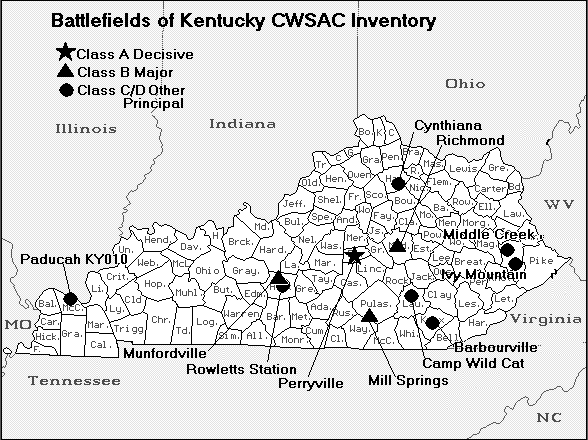
|
| Principal Civil War Battlefields in Kentucky |
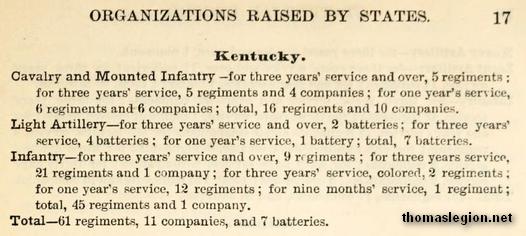
(About) Frederick Phisterer's figures for Kentucky's contributions to the
Union Army. While units such as home guard and state militia are not generally reported herein, other Civil War statisticians,
namely Fox and Dyer, do give more detailed figures for units in Federal service. (Military organizations and units which served
primarily within any given state usually had their service recorded or preserved by their respective members
or local historians.) Phisterer, Frederick. Statistical Record of the
Armies of the United States (1883).
On July 4, 1862, Morgan and his men left Knoxville, Tennessee, and captured
Tompkinsville five days later. After a brief stop in Glasgow, where many of Morgan's troops were from, they continued to Lebanon,
capturing it on July 12. From there, the cavalry stopped in Harrodsburg and Georgetown, and upon seeing that Lexington was
too heavily fortified, turned their attention to the town of Cynthiana. Morgan was again victorious at Cynthiana, but with
Federal reinforcements closing in on him, he paroled all the captured soldiers from the battle and rode to Paris.
On their exit from the Commonwealth, the cavalry picked up 50 recruits
at Richmond. They also stopped in Somerset, where Morgan instructed his telegrapher, George "Lightning" Ellsworth to send
taunting messages to General Jeremiah Boyle and publisher George Prentice. At the completion of his escape through the Commonwealth,
Morgan claimed to have captured and paroled 1,200 enemy soldiers, recruited 300 men and acquired several
hundred horses for his cavalry, used or destroyed supplies in seventeen towns, and incurred fewer than 100 casualties.
Morgan's exploits encouraged Confederate
General Edmund Kirby Smith to move on Kentucky. After conferring with General Braxton Bragg at Chattanooga, Smith moved to
drive George W. Morgan from Cumberland Gap in August 1862. Both generals understood that Smith would capture Cumberland Gap, then join Bragg in Middle Tennessee.
When the two armies met, Bragg would command the combined force against Don Carlos Buell in Nashville. Once Nashville
was captured, Bragg and Smith would commence an invasion of Kentucky.
As the battle at Cumberland Gap wore on, Morgan refused to retreat or
surrender his position. Thinking an invasion of Kentucky was preferable to a long siege on the Gap, Smith left a detachment
to handle Morgan and proceeded toward Lexington, abandoning the plan to join Bragg and capture Nashville. The move forced
Bragg's hand, and he too entered Kentucky on August 28. As Smith progressed toward Lexington, Indiana governor Oliver P. Morton
decided that Governor Robinson was doing too little to support the Union cause. He dispatched regiments across the Ohio into
Louisville, and considered himself governor of both Indiana and Kentucky.
Upon learning of Smith's advance into Kentucky, General "Bull" Nelson
prepared to engage the invading army at the Kentucky River to take advantage of the better terrain, but delayed the engagement
so that more reinforcements could arrive. He ordered the brigades under Mahlon Manson and Charles Cruft not to attack Smith,
but to withdraw to Lexington, but the orders either were not delivered in time, or they were ignored.
After some preliminary skirmishes, Smith's army met Mahlon's brigade at
Richmond, Kentucky on August 30. Smith's more experienced troops broke the center of the Union line, and Mahlon fell back
to Richmond Cemetery. By the afternoon, General Nelson arrived and tried to rally the troops. Riding along the front of the
Federal line, the portly Nelson exclaimed, "Boys, if they can't hit me, they can't hit a barn door!" Unfortunately for Nelson,
he was soon hit twice by Confederate gunfire. Though Nelson was seriously wounded, he escaped the battle as Confederate cavalry
moved to cut off the Union retreat. He left behind 206 killed, 844 wounded, and 4,303 missing. With only 98 killed, 492 wounded,
and 10 missing, Smith had won one of the most complete Confederate victories of the entire war.
While Smith was continuing on to Lexington, Bragg was just entering
Kentucky, having delayed at Chattanooga until August 28. Bragg was told that there were ample supplies in the Glasgow area,
but upon learning that Bragg had entered Kentucky, Buell left George Thomas to guard Nashville and moved the rest of his army
to heavily-fortified Bowling Green.
Meanwhile, Smith had dispatched Colonel John Scott to look for Bragg.
On the night of September 13, Scott encountered John T. Wilder at Munfordville, and demanded his surrender. Scott requested
the aid of James Chalmers' Mississippi brigade, which moved to support Scott throughout the night. The assault commenced the
next morning, and though outnumbered, Scott's forces inflicted more than 200 casualties in the early fighting. At 9:30 AM,
Chalmers tried to intimidate Wilder into surrender, sending a flag of truce with the message, "You have made a gallant defense
of your position, and to avoid further bloodshed I demand an unconditional surrender of your forces. I have six regiments
of infantry, one battalion of infantry sharpshooters, and have just been reinforced by a brigade of cavalry, under Colonel
Scott, with two battalions of infantry." Upon receiving this message, Wilder replied "Thank you for your compliments. If you
wish to avoid further bloodshed, keep out of the reach of my guns."
Wilder was soon reinforced by Colonel Cyrus L. Dunham, who brought a
force of 4,000 men. Scott and Chalmers sought assistance from Bragg's main army. Bragg was incensed, but arrived the next
day to take charge of the battle. Bragg deployed forces under William J. Hardee and Leonidas Polk to surround the town, delaying
his assault until September 17. Bragg sent another request for the force's surrender. At a council of war, Wilder made an
unusual request of Bragg's subordinate, Simon B. Buckner– that he be allowed to inspect the forces that now surrounded
him to determine whether surrender were the correct course of action. Delighted by this supreme compliment, Buckner obliged,
and after surveying the Confederate line, Wilder surrendered.
Wilder's force of some 4,000 men was paroled and directed to Bowling
Green, where Bragg hoped they would be a drain on Buell's supplies. The delay caused by the Confederate victory at Munfordville
may well have cost them a much more important prize– Louisville.
| Total Kentucky Civil War regiments and units |
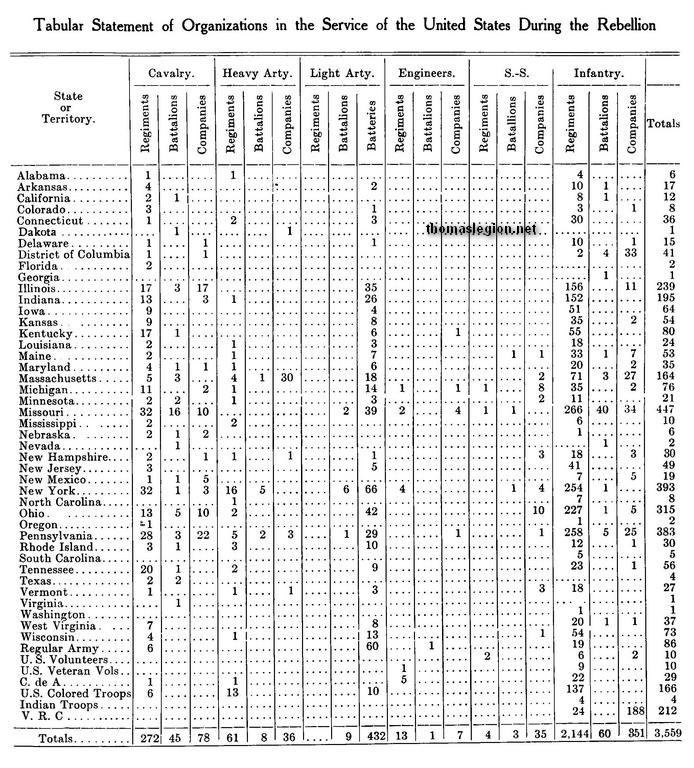
|
| Total Civil War regiments and units raised by each state |
| Kentucky in the Civil War |
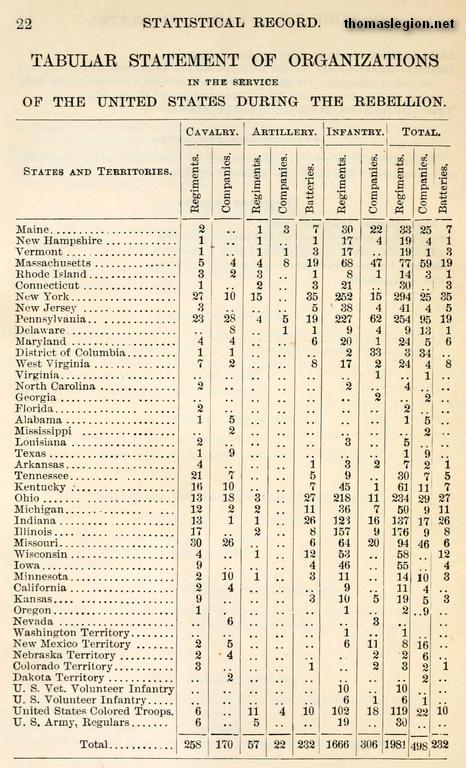
|
| Total Civil War units raised by each state |
(About) Acclaimed Civil War statisticians Phisterer (left) and Dyer (right)
show the total number of regiments, battalions, and other units, raised for the Union military during the course of the Civil
War. Numbers and tabulations, however, vary betwixt the two, mainly because of methodology applied by the statistician. While
Dyer included battalions and sharpshooters, for instance, Phisterer did not. On the selected pages, Phisterer also does not
differentiate between heavy and light artillery, nor does he offer figures for engineers. (Absent from both counts are
contributions to the Navy and Marines; which are covered in other chapters.) Some units, depending on the writer, were also
counted twice: once as an initial 90 day regiment and the second time when the unit was re-designated as a 3 year regiment.
While one also included or counted a regiment during its formation, the other may have dismissed it from the total because
the regiment failed to complete its formation or organization. And at times two regiments consolidated during the war, thus
causing the statistician to add or count the consolidated unit as a third regiment. Notwithstanding, both statisticians qualify
their methodology and offer more detailed accounts in other chapters of their respective works. See also Phisterer, Frederick.
Statistical Record of the Armies of the United States (1883); Dyer, Frederick H. A Compendium of the War of the Rebellion
(1908).
While Bragg rested his troops and planned his next move, Buell marched north
from Bowling Green and arrived in Louisville on September 25. Seeing his primary objective fallen into Union hands, Bragg
turned to Bardstown, where he had expected to meet Smith. Smith was actually operating independently near Frankfort, and Bragg,
now painfully aware that the lack of cooperation with Smith might prove the Confederates' undoing in Kentucky, began to disperse
his troops into defensive postures at Bardstown, Shelbyville, and Danville.
Both Bragg and Smith had been disappointed with the number of volunteers
from Kentucky. Wagonloads of rifles had been sent to the Commonwealth to equip the anticipated recruits, but although Confederate
sympathies were high, willing volunteers were not, and many of the rifles remained on the wagons. Bragg hoped to rally potential
recruits by installing Richard Hawes, governor of Kentucky's Confederate shadow government, in an inauguration ceremony in
Frankfort. The elected government fled to Louisville just before the Confederates arrived in Frankfort.
The ceremony took place
on October 4, 1862. First, Bragg addressed the assembled partisan crowd, promising to defend the Commonwealth. Then Hawes,
who had taken the oath of office months earlier while traveling with Bragg's Army of Tennessee, delivered a lengthy inaugural
address. He told the crowd that the provisional government would "institute as far as possible such civil institutions, as
will protect persons and property, until the people in their sovereign capacity can establish a permanent Government founded
on the will of the majority."
The promises made by Bragg and Hawes were short-lived. Before the inaugural
ball could be held, Buell's forces had descended on the state capital, firing artillery shells that shattered the jovial atmosphere
and put the Confederate forces to flight. Bragg had sorely underestimated Buell's ability to make a rapid advance on his position.
While preparations were being made for Hawes' inauguration, Buell was already forcing the Confederate army from Shelbyville.
Bragg ordered Leonidas Polk from Bardstown to attack Buell's flank, but Polk was already under attack and retreating to Bryantsville.
Bragg began a retreat from Frankfort to Harrodsburg to regroup with Polk. Meanwhile, Smith prepared to defend Lexington, where
he assumed the bulk of Buell's force would be directed.
By October 7, Polk's forces had fallen back to the town of Perryville.
The dry summer of 1862 had left water in short supply, and when the Union troops learned of water in Perryville's Doctor's
Creek, they began to move on the Confederate position. Bragg shared Smith's assumption that the bulk of the Federal attack
would be directed at Lexington and Frankfort, and ordered Polk's forces to attack and destroy the approaching Union force
before proceeding to Versailles to meet Smith. The Confederate soldiers in Perryville, however, realized that a much larger
force was approaching, and assumed a defensive posture. In fact, Buell, Charles Champion Gilbert, Alexander McCook, and Thomas
Crittenden were all approaching Perryville.
The Confederates were not the only ones to misjudge the situation, however.
When Bragg learned that his men had not attacked as ordered, he came to Perryville himself to lead the attack. In realigning
to an attack posture, the Confederates stirred such a cloud of dust that the approaching Union force believed they were retreating
to Harrodsburg. This gave Bragg's men the advantage of surprise when they opened fire on McCook's forces at 2 PM on October
8. While McCook was being pushed back on the left flank, the Union center held strong until the right flank began to collapse.
It was not until late afternoon that Buell learned of McCook's plight,
whereupon he sent two brigades from Gilbert's corps to reinforce him. This halted the Confederate advance on McCook north
of Perryville. Meanwhile, small Confederate brigades encountered Gilbert's force of 20,000 men to the west and Crittenden's
force, also 20,000 strong, to the south. Only then did Bragg realize that he was facing Buell's main force, and that he was
vastly outnumbered. As night approached and halted the battle, Bragg conferred with his officers and decided to retreat to
Harrodsburg to meet Smith. From Harrodsburg, the Confederates exited Kentucky through Cumberland Gap. For the remainder of
the war, there would be no concerted efforts by the Confederacy to hold Kentucky.
On December 17, 1862, under the terms of General Order No. 11, thirty
Jewish families, longtime residents all, were forced from their homes. Cesar Kaskel, a prominent local Jewish businessman,
dispatched a telegram to President Lincoln, and met with him, eventually succeeding in getting the order revoked.
His inability to engage Bragg and Smith on their retreat from Kentucky
led to Buell being replaced by General William Rosecrans. Rosecrans encamped at Nashville during the fall and early winter
of 1862. Believing that Rosecrans would begin a campaign as soon as sufficient supplies were accumulated, Bragg dispatched
John Hunt Morgan back into Kentucky in December 1862 to cut the supply line afforded Rosecrans by the Louisville and Nashville
Railroad.
Morgan's men crossed into Kentucky on December 22 and captured a Union
supply wagon bound for Glasgow. On Christmas Day, Morgan's men rode through Glasgow, bound for Bacon Creek Station and the
L&N bridge span. After quelling the stiff Federal resistance, Morgan's men destroyed the bridge and several miles of railroad
track. Whatever else might happen, they had succeeded in disrupting Rosecrans' supply line.
From Bacon Creek, Morgan rode to Elizabethtown, arriving on December
27. The Union commander, Colonel H. S. Smith, demanded Morgan's surrender, but Morgan turned the tables, surrounded Smith,
and, after a short skirmish, accepted his surrender. Again, Morgan destroyed the L&N infrastructure in the area, and then
began planning an escape back to Tennessee.
| American Civil War and Kentucky Map |
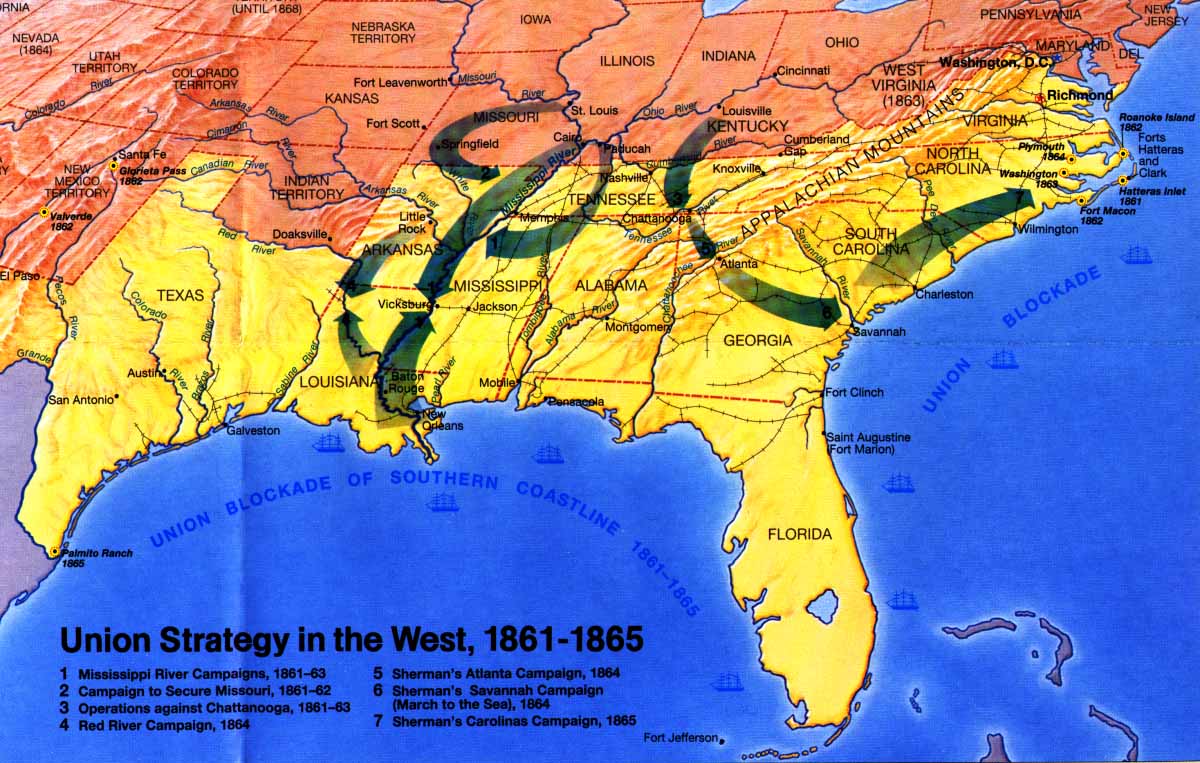
|
| (Map) Union strategy in the West |
Colonel John M. Harlan's artillery shelled Morgan's force as it crossed
the Rolling Fork River on December 29, seriously wounding First Brigade commander Basil W. Duke. Duke was taken to Bardstown
for medical treatment, however, and recovered in time to rejoin the Confederate retreat the next day.
Freezing rain plagued Morgan's men as they encamped at Springfield on
the night of December 30. Worse yet, scouts reported a massive Union force concentrated nine miles away at Lebanon. With Frank
Wolford's men moving on his position, Morgan made the difficult decision to move out just after midnight in ever-worsening
weather. He ordered a few companies to create a diversion, feigning an attack on Lebanon and burning fence rails to give the
appearance of campfires, while the main body of his force continued to Campbellsville. The plan worked, and following a march
that many described as their most miserable night of the war, Morgan's men arrived safely in Campbellsville on New Year's
Eve and captured some welcome supplies. The following day, they proceeded through Columbia, and returned to Tennessee on January
3.
Following the Christmas Raid, there were only minor incursions into
Kentucky by various units under Roy Cluke, John Pegram, Humphrey Marshall, among others. Frustrated Union commanders could
only react to these unpredictable raids. Morgan would soon do them a favor, however, by raising the visibility of his next
raid.
It was widely reported that since his December 1862 marriage, Morgan
had lost some of his bravado. Morgan, eager to dispel such rumors and weary of guarding Bragg's left flank, proposed a raid
through Kentucky and across the Ohio River. Bragg, fearing an attack from Rosecrans, welcomed the idea of a distraction that
would take the pressure off his Army of Tennessee. Morgan gathered his men to an area between Liberty and Alexandria, Tennessee.
On June 10, he addressed his unit, telling them that Bragg had sanctioned a raid to Louisville, and if conditions permitted,
across the Ohio River into Indiana and possibly Ohio. He confided Bragg's true orders—to halt at the Ohio River—only
to trusted confidant Basil Duke.
| Kentucky Civil War Map of Battlefields |
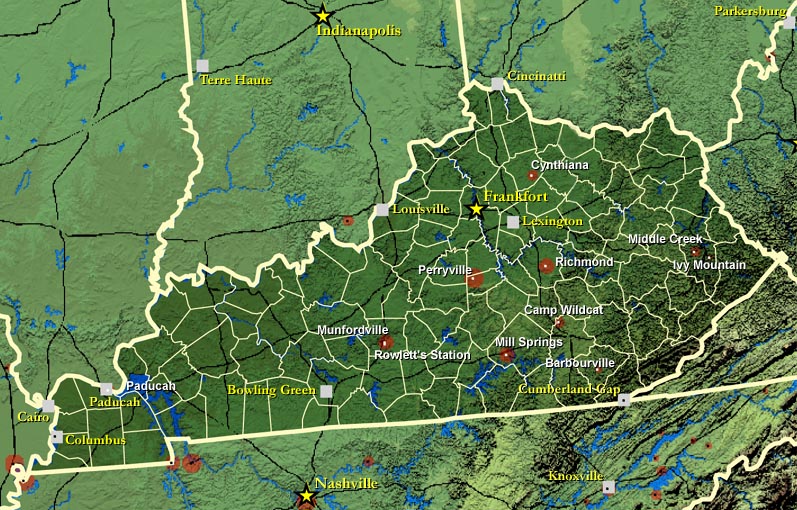
|
| Map of Kentucky Civil War Battles |
The raid
was delayed by orders to intercept a Union raiding party moving on Knoxville, Tennessee, but after three miserable weeks of
floundering through muddy conditions, Morgan's men still had not located the enemy. They finally began entering Kentucky on July 2, 1863. Two days later, Morgan engaged Colonel Orlando Moore's forces at Tebb's Bend,
a bridge crossing the Green River near Campbellsville. As was his custom, Morgan demanded an unconditional surrender, but
Moore, noting that this was Independence Day, replied "It is a bad day for surrender, and I would rather not." Moore's forces
won the day, and Morgan, having suffered 71 casualties, decided to bypass the bridge.
Morgan again encountered resistance at Lebanon where, despite the Confederate
victory, his nineteen-year-old brother Tom was killed. From Lebanon, Morgan's men made haste through Springfield toward Bardstown,
where they learned that Union soldiers were less than a day behind, and that Louisville was already bracing for another attack.
Morgan had the advantage of surprise, however, having selected Brandenburg as his target instead. He sent an advance detachment
to make preparations for crossing the Ohio, and on July 7, they captured two steamboats, the John B. McCombs and the Alice
Dean. By midnight, all of Morgan's men were on Indiana soil.
Over the next few weeks, Morgan rode along the course of the Ohio River,
raiding Indiana and Ohio. On July 19, Federal forces captured Duke and 700 of Morgan's men, but Morgan escaped with 1,100
others. Union pursuit was heavy, and Morgan lost exhausted men daily, his command dwindling to 363 men by the time he surrendered
on July 26, 1863.
Morgan was taken to a penitentiary in Columbus, Ohio, but escaped with
several of his officers in November 1863. Despite the threat of a court martial from Bragg for disobeying orders, the Confederacy
so desperately needed leaders that Morgan was restored to his command position.
Following Morgan's capture in the summer of 1863, there were no major
engagements fought in Kentucky until spring of 1864. Portions of three infantry regiments from Bragg's army had requested
to reorganize as a mounted infantry under Abraham Buford, but the Confederacy had no horses to supply them. In response, Nathan
Bedford Forrest, who had been operating in Mississippi, began to organize a raid on western Tennessee and Kentucky. Besides
obtaining mounts for the mounted-infantry-to-be, Forrest intended to disrupt Union supply lines, obtain general provisions
for Confederate forces, and discourage enlistment of blacks in Kentucky into the Union army.
On March 25, 1864, Forrest commenced his attack. He met Colonel Stephen
G. Hicks at Fort Anderson and demanded an unconditional surrender. Knowing that Forrest's main objectives were to obtain supplies
and horses, Hicks declined. For the most part, Hicks was right in his assumption that Forrest would not assault the fort,
but Confederate colonel Albert P. Thompson, a native of the area, did briefly attempt to capture it before being killed with
24 men from his unit. Forrest held the city for ten hours, destroying the Union headquarters, as well as the buildings housing
the quartermaster and commissary. Forrest also captured a total of 200 horses and mules before withdrawing to Mayfield. Following
the raid, Forrest granted furlough to the Kentuckians under his command so they could secure better clothing and mounts. As
agreed, every man reported back to Trenton, Tennessee on April 4.
Unionist newspapers bragged after the raid that Union forces had hidden
the best horses in the area and that Forrest had only captured horses stolen from private citizens. Furious, Forrest ordered
Buford back into Kentucky. Buford's men arrived on April 14, forced Hicks back into the fort, and captured an additional 140
horses in the foundry, exactly where the newspaper reports had placed them. They then rejoined Forrest in Tennessee. The raid
was not only successful in terms of gaining additional mounts, but provided a diversion
for Forrest's attack on Fort Pillow, Tennessee.
| Kentucky Civil War Marker |
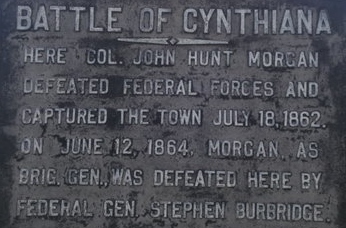
|
| Battle of Cynthiana |
At dawn, June 11, 1864, the last major battle, known as 2nd Battle
of Cynthiana (June 11-12), was fought on Kentucky soil. Brig. Gen. John Hunt Morgan, and his new cavalry division of
1,200, approached Cynthiana. Union Col. Conrad Garis, with the 168th Regiment Ohio Volunteer Infantry and some home guard
troops, approximately 300 men total, constituted the Federal forces at Cynthiana. Morgan divided his men into three columns, surrounded
the town and launched an attack at the covered bridge, driving the Union forces back towards the depot and north along the
railroad. The Confederates set fire to the town, destroying many buildings and killing some of the Federal troops.
As the fighting flared in Cynthiana, another Union force, approximately
750 men of the 171st Ohio National Guard under the command of Brig. Gen. Edward Hobson, arrived by train about a mile
north of Cynthiana at Kellar’s Bridge. Morgan trapped this new Union force in a meander of the Licking River. After
some fighting, Morgan forced Hobson to surrender. This engagement, Morgan's last victory, was known as the Battle of Keller's
Bridge. Morgan now had nearly 1,300 Union prisoners of war camping with him overnight in line of battle.
With little ammunition, Morgan recklessly decided to stay and fight
an expected larger Federal force. Maj. Gen. Stephen G. Burbridge with 2,400 men, a combined force of Ohio, Kentucky, and Michigan
mounted infantry and cavalry, attacked Morgan at dawn on June 12. The Union forces drove the Rebels back, causing them to flee
into town, where many were captured or killed. General Morgan and many of his officers escaped. Combined casualties in the
separate Union forces totaled 1,092 men, while Morgan was estimated to have lost about 1,000 men, although no official
records exist. Cynthiana demonstrated that Union numbers and mobility were starting
to take their toll; Confederate cavalry and partisans could no longer raid with impunity.
On August 22, 1864, Morgan was placed
in command of the Trans-Allegheny Department, embracing the Confederate
forces in eastern Tennessee and southwestern Virginia. While attempting to escape during a raid on Greeneville, Tennessee,
however, the elusive Morgan was surprised by a Union attack and was shot in the back and killed by Federal cavalry on September
4, 1864. See also Kentucky Civil War Timeline.
In response to the growing problem of guerrilla campaigns throughout
1863 and 1864, in June 1864, Maj. Gen. Stephen Burbridge was given command over the state of Kentucky. This began an extended
period of military control that would endure through early 1865, beginning with martial law authorized by President Abraham
Lincoln.
On July 16, 1864, Burbridge issued Order No. 59 which declared: "Whenever
an unarmed Union citizen is murdered, four guerrillas will be selected from the prison and publicly shot to death at
the most convenient place near the scene of the outrages." During Burbridge's rule in Kentucky, he, on baseless and groundless
charges of treason and other high crimes, indiscriminately directed the execution and imprisonment of numerous
citizens, including well-known public officials.
While commanding Kentucky, Burbridge was accused of insubordination
towards Governor Thomas E. Bramlette, including an attempt to assume control of Bramlette's troops and arms. Consequently,
in February 1865, Burbridge was dismissed from commanding operations in Kentucky, and he subsequently resigned from the army. Confederates
remembered him as the "Butcher of Kentucky". See also Kentucky Civil War History and Kentucky in the American Civil War: Kentucky (1861-1865).
| Military Reconstruction Map |
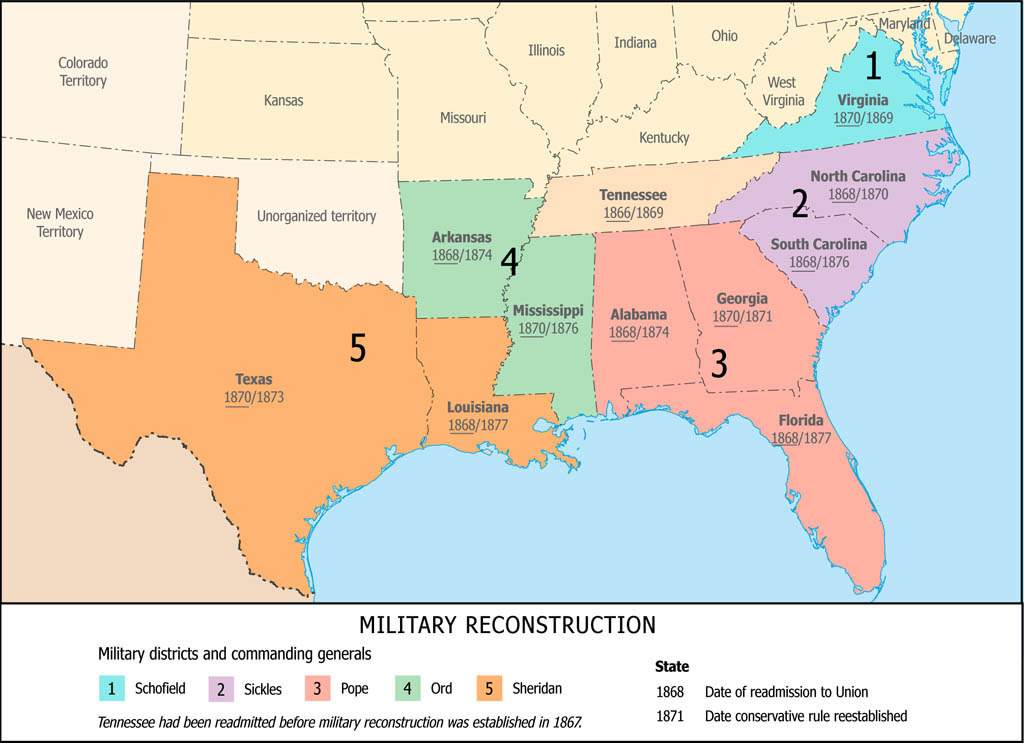
|
| Kentucky was exempt from Military Reconstruction |
Reconstruction
Before the Civil War, Kentucky was primarily an agricultural state, with
extensive hemp and tobacco plantings. After the war, the hemp industry declined but the tobacco industry boomed.
Although Kentucky was a slave state, it was not subject to military
occupation during the Reconstruction Period. It was subject to the Freedmen's Bureau and a congressional investigation into
the propriety of its elected officials. During the election of 1865, ratification of the Thirteenth Amendment was a major
political issue. Kentucky eventually rejected the Thirteenth, Fourteenth, and Fifteenth Amendments. Democrats prevailed in
the election, and one of their first acts was to repeal the Expatriation Act of 1862,
thus restoring the citizenship of Confederates.
Kentucky became internationally known for its violent feuds, especially
in the mountains. They pitted the men in extended clans against each other for decades, often using assassination and arson
as weapons, along with ambushes, gunfights, and pre-arranged shootouts. Some of the feuds were continuations of violent local
Civil War episodes. Journalists often wrote about the violence, using stereotypes that city folks had developed about Appalachia;
they interpreted the feuds as the inevitable product of profound ignorance, poverty, and isolation, and perhaps even interbreeding.
In reality, the leading participants were typically well-to-do local elites with networks of clients who were fighting for
local political power.
See also
Sources: Official Records of the Union and Confederate Armies; National
Park Service; National Archives; Library of Congress; US Census Bureau; The Union Army (1908); Fox, William F. Regimental
Losses in the American Civil War (1889); Dyer, Frederick H. A Compendium of the War of the Rebellion (1908); Phisterer, Frederick.
Statistical Record of the Armies of the United States (1883); Hardesty,
Jesse. Killed and Died of Wounds in the Union Army during the Civil War (1915) Wright-Eley Co.; Cantrell,
Doug, et al. eds. Kentucky Through The Centuries: A Collection Of Documents And Essays (2009); Chandler, Albert B. Heroes,
Plain Folks, and Skunks: The Life and Times of Happy Chandler (1989); Coleman, J. Winston. Slavery Times in Kentucky, 1940;
Harrison, Lowell H. The Antislavery Movement in Kentucky, 1978; Lowell Hayes Harrison, and James C. Klotter, A New History
of Kentucky, Lexington, KY: University Press of Kentucky, 1997; Bodley, Temple and Samuel M. Wilson. History of Kentucky 4
vols. (1928); Caudill, Harry M., Night Comes to the Cumberlands (1963). ISBN 0-316-13212-8; Channing, Steven. Kentucky: A
Bicentennial History (1977); Clark, Thomas Dionysius. A History of Kentucky (many editions, 1937–1992); Collins, Lewis.
History of Kentucky (1880); Harrison, Lowell H. and James C. Klotter. A New History of Kentucky (1997); Kleber, John E. et
al. The Kentucky Encyclopedia (1992), standard reference history; Klotter, James C. Our Kentucky: A Study of the Bluegrass
State (2000), high school text; Lucas, Marion Brunson and Wright, George C. A History of Blacks in Kentucky 2 vols. (1992);
Share, Allen J. Cities in the Commonwealth: Two Centuries of Urban Life in Kentucky (1982); Wallis, Frederick A. and Hambleton
Tapp. A Sesqui-Centennial History of Kentucky 4 vols. (1945); Ward, William S., A Literary History of Kentucky (1988) (ISBN
0-87049-578-X); WPA, Kentucky: A Guide to the Bluegrass State (1939), classic guide; Yater, George H. (1987). Two Hundred
Years at the Fall of the Ohio: A History of Louisville and Jefferson County (2nd ed.). Filson Club, Incorporated. ISBN 0-9601072-3-1;
Bailey, Bill (1995). Kentucky State Parks. Saginaw, Michigan: Glovebox Guidebooks of America. ISBN 1-881139-13-1; Kent Masterson
Brown, ed. (2000). The Civil War in Kentucky: Battle for the Bluegrass. Mason City, Iowa: Savas Publishing Company. ISBN 1-882810-47-3;
Cantrell, Doug (2005). Kentucky Through the Centuries: A Collection of Documents & Essays. Dubuque, Iowa: Kendall/Hunt
Publishing Company. ISBN 0-7575-2012-X; Encyclopedia of Kentucky. New York City, New York: Somerset Publishers. 1987. ISBN
0-403-09981-1; Harrison, Lowell H. (1975). The Civil War in Kentucky. Lexington, Kentucky: The University Press of Kentucky.
ISBN 0-8131-0209-X; Lowell H. Harrison, ed. (2004). Kentucky's Governors. Lexington, Kentucky: The University Press of Kentucky.
ISBN 0-8131-2326-7; Kleber, John E., ed. (1992). The Kentucky Encyclopedia. Associate editors: Thomas D. Clark, Lowell H.
Harrison, and James C. Klotter. Lexington, Kentucky: The University Press of Kentucky. ISBN 0-8131-1772-0; Powell, Robert
A. (1976). Kentucky Governors. Frankfort, Kentucky: Kentucky Images. OCLC 2690774; Jerlene Rose, ed. (2005). Kentucky's Civil
War 1861–1865. Clay City, Kentucky: Back Home in Kentucky, Inc.. ISBN 0-9769231-2-2; Thomas, Edison H. (1975). John
Hunt Morgan and His Raiders. Lexington, Kentucky: The University Press of Kentucky. ISBN 0-8131-0214-6.
Return to American Civil War Homepage

|

|

|

